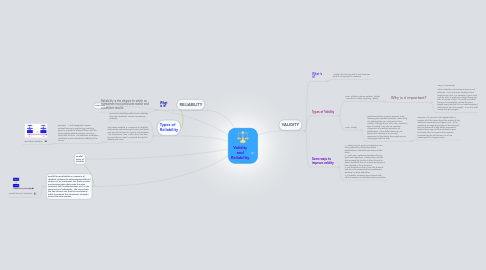
1. Parallel forms of reliabilty
2. Parallel forms reliability is a measure of reliability obtained by administering different versions of an assessment tool (both versions must contain items that probe the same construct, skill, knowledge base, etc.) to the same group of individuals. The scores from the two versions can then be correlated in order to evaluate the consistency of results across alternate versions.
2.1. Parallel froms of reliability
3. New node
4. Types of Reliability
4.1. Test-retest reliability,Parallel forms reliability, Inter-rater reliability, Internal consistency reliability
4.2. Test-retest reliability is a measure of reliability obtained by administering the same test twice over a period of time to a group of individuals. The scores from Time 1 and Time 2 can then be correlated in order to evaluate the test for stability over time.
4.2.1. Example: A test designed to assess student learning in psychology could be given to a group of students twice, with the second administration perhaps coming a week after the first. The obtained correlation coefficient would indicate the stability of the scores.
4.2.1.1. Test Retest reliability
5. RELIABILITY
5.1. What is it?
5.1.1. Reliability is the degree to which an assessment tool produces stable and consistent results.
6. VALIDITY
6.1. What is it?
6.1.1. Validity refers to how well a test measures what it is purported to measure.
6.2. Types of Validity
6.2.1. Face Validity, Criterion-Related Validity, Formative Validity, Sampling Validity
6.2.1.1. Why is it important?
6.2.1.1.1. Why is it necessary? While reliability is necessary, it alone is not sufficient. For a test to be reliable, it also needs to be valid. For example, if your scale is off by 5 lbs, it reads your weight every day with an excess of 5lbs. The scale is reliable because it consistently reports the same weight every day, but it is not valid because it adds 5lbs to your true weight. It is not a valid measure of your weight.
6.2.2. Face Validity:
6.2.2.1. ascertains that the measure appears to be assessing the intended construct under study. The stakeholders can easily assess face validity. Although this is not a very “scientific” type of validity, it may be an essential component in enlisting motivation of stakeholders. If the stakeholders do not believe the measure is an accurate assessment of the ability, they may become disengaged with the task.
6.2.2.1.1. Example: If a measure of art appreciation is created all of the items should be related to the different components and types of art. If the questions are regarding historical time periods, with no reference to any artistic movement, stakeholders may not be motivated to give their best effort or invest in this measure because they do not believe it is a true assessment of art appreciation.
6.3. Some ways to improve validity
6.3.1. 1. Make sure your goals and objectives are clearly defined and operationalized. Expectations of students should be written down. 2. Match your assessment measure to your goals and objectives. Additionally, have the test reviewed by faculty at other schools to obtain feedback from an outside party who is less invested in the instrument. 3. Get students involved; have the students look over the assessment for troublesome wording, or other difficulties. 4. If possible, compare your measure with other measures, or data that may be available.
